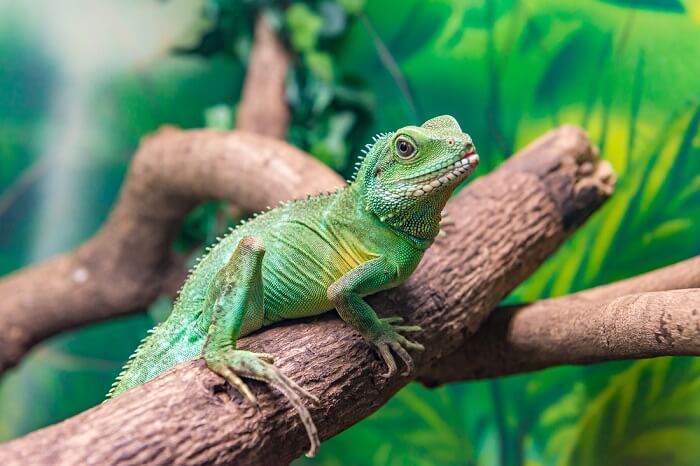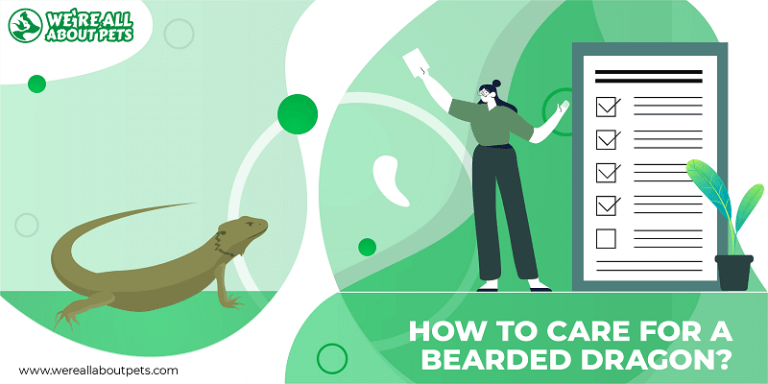10 Different Types of Pet Turtle Breeds You Should Know
This page contains affiliate links. We may earn money or products from the companies mentioned in this post through our independently chosen links, which earn us a commission. Learn More
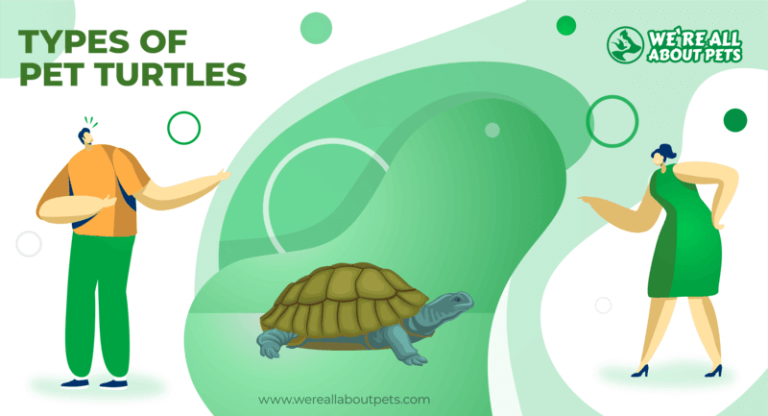
You don’t need to be a reptile expert to know a little bit about turtles. These fascinating reptiles are known for carrying their homes around on their backs and for being able to retreat into their shells for protection. Unless you’ve owned one yourself, however, your knowledge may not go much futher.
What you may be surprised to learn is that turtles make fascinating pets. Their appearance is completely unique depending on the species and they are relatively undemanding in nature as pets.
While turtles may be fairly low maintenance, every pet comes with its challenges. From the cost to keep a pet turtle to its dietary requirements, it’s important to know what you’re getting into. Read on to learn about the most common types of pet turtles so you can decide which one is right for you.
10 Types of Pet Turtles
Turtles are a type of reptile characterized by a bony or cartilaginous shell. Though it may look like they’re simply carrying the shell around on their back, a turtle’s shell is just as much a part of its body as your skeleton is part of yours. This is just one of the many things that makes turtles fascinating.
Though turtles as a whole are an incredibly interesting group of reptiles, each and every species is unique. Before you make up your mind about getting a pet turtle, think about what kind you want.
When it comes to choosing a type of pet turtle, the biggest decision you need to make is between aquatic and terrestrial turtles. The setup for an aquatic turtle is a little more complex than for a terrestrial turtle because you’ll need a filtration system to control water temperature and water quality on top of the usual UVB lighting and heating.
Here’s a quick overview of some of the most popular pet turtle types:
1. Painted Turtle (Chrysemys picta)
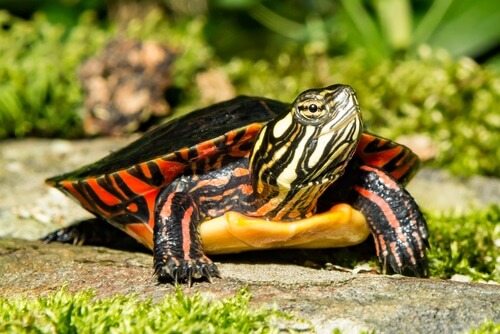
- Origin: North America
- Price: $20 to $40
- Size: Up to 10 inches
- Color: Dark green with colored stripes
Sometimes simply referred to as the painted turtle, the Western painted turtle is the most widespread native turtle in North America. This species is the only species in the genus Chrysemys, and it is part of the Emydidae family of pond turtles.
Painted turtles feed on aquatic vegetation and algae, as well as small water creatures including fish, insects, and crustaceans. This species generally reaches up to 10 inches in size, though males of the species are a little smaller than females.
Where the painted turtle gets its name is from the coloration on its carapace. These turtles are usually olive green to black in color with red, orange, or yellow stripes on the legs and neck. Subspecies of painted turtle can be identified by the coloration on their shells.
2. Red-Eared Slider (Trachemys scripta elegans)
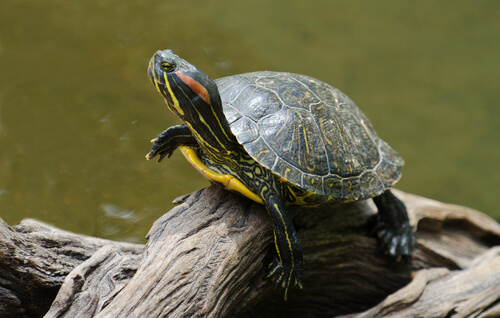
- Origin: United States
- Price: $10 to $30
- Size: Up to 16 inches
- Color: Dark green, brown
The red-eared slider turtle is one of the most popular pet turtle species. They tend to be more sociable and friendlier than other species, and they are very active. These turtles have an average adult size up to 16 inches and are easily identified by the red coloration over each year.
Though pet turtles are generally housed indoors, this particular species make great pond turtles. Just make sure to provide proper filtration to maintain clean water as well as UV lighting. With proper care, red-eared sliders can liver up to 50 years old.
3. Common Snapping Turtle (Chelydra serpentina)

- Origin: North America
- Price: $20 to $40
- Size: Up to 20 inches
- Color: Brown
A large freshwater species native to North America, the common snapping turtle can be found as far north as Canada all the way south to Florida. There are several subspecies of snapping turtle, but the common snapping turtle is more commonly kept as a pet than the larger alligator snapping turtle.
Snapping turtles are easy to identify by their strong, beak-like jaws and their highly mobile head and neck. These aquatic turtles have an extremely long lifespan up to 100 years but delayed sexual maturity. They also have a high and variable mortality rate for embryos and hatchlings.
4. African Sideneck Turtle (Coenobita brevimanus)
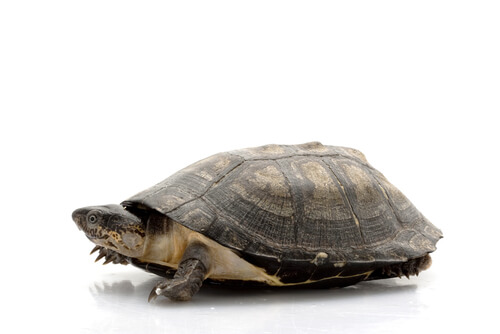
- Origin: Africa
- Price: $50 to $100
- Size: Up to 18 inches
- Color: Brown
When you picture a turtle, you probably imagine a reptile that can retract its head and legs into its shell for protection. What makes the African sideneck turtle unique is that it doesn’t have this ability. Instead, it has a neck long enough that it tucks its head to the side, under the top of its carapace.
The African sideneck turtle is a very large species, growing up to 18 inches at its adult size. This being the case, these turtles require at least a 75-gallon tank. These turtles are also very sensitive, so they need an adequate filtration system to maintain clean water.
One other thing to know about these turtles is that they can be very curious by nature. Making the effort to spend time with and interact with your turtle will help keep it tame.
5. Eastern Box Turtle (Terrapene carolina carolina)
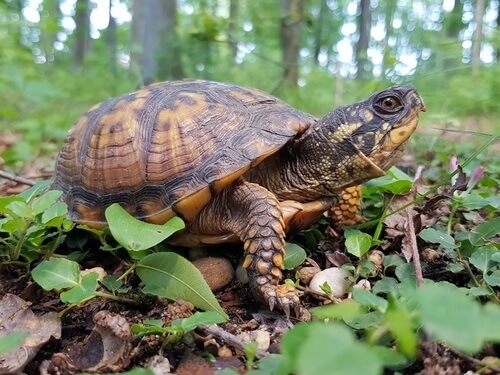
- Origin: Eastern United States
- Price: $25 to $50
- Size: Up to 7 inches
- Color: Brown/black with yellow pattern
One of the most popular terrestrial turtles kept as pets, the Eastern box turtle is a fairly small species with modest care requirements. Box turtles prefer a humid environment with moist substrate and a shallow pool of water in their enclosure. They also need a UVB basking light.
While box turtles can be a little shy, they generally respond well to regular handling and they don’t tend to be aggressive. Regular interaction helps keep these turtles tame and you will even notice your turtle’s personality coming out after a while.
6. Mississippi Map Turtle (Graptemys pseudogeographica)
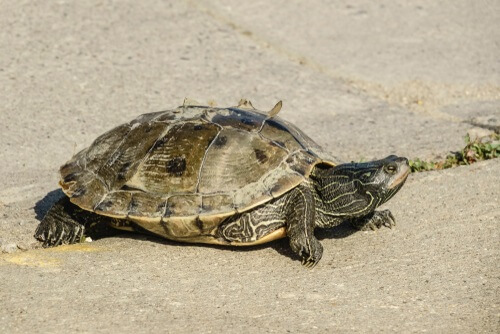
- Origin: Central United States
- Price: $20 to $75
- Size: Up to 10 inches
- Color: Grey with yellow lines
This medium-sized turtle species is named for the map-like lines on the carapace that look like the lines of a map. Native to the central United States, these turtles can be found throughout the Mississippi Valley and southward into the Gulf States.
Mississippi map turtles prefer habitats with abundant vegetation, so they’re usually found in rivers, lakes, and large streams rather than isolated farm ponds. These turtles grow up to 10 inches in length with females of the species usually being much larger than the males.
7. Spotted Turtle (Glemmys guttata)

- Origin: North America
- Price: $75 to $150
- Size: Up to 5 inches
- Color: Gray to black with spots
These small turtles are the only species in the genus Clemmys. Spotted turtles measure up to 5 inches in length and have a dark-colored carapace covered with tiny yellow round spots. Another feature that differentiates this species from others is that it doesn’t have a central ridge or keel on the carapace.
In the wild, spotted turtles are active hunters. They are omnivorous and feed exclusively in the water, eating everything from aquatic vegetation and green algae to insect larvae, worms, crustaceans, tadpoles, salamanders, and small fish.
8. Common Wood Turtle (Glyptemys insculpta)
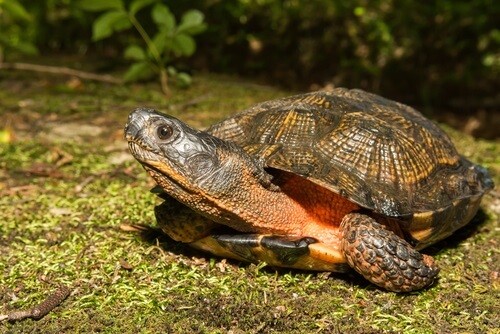
- Origin: North America
- Price: $20 to $100
- Size: Up to 9 inches
- Color: Yellow and black
Known for its friendly demeanor, the wood turtle is also a hardy turtle species. Wood turtles are a little easier to keep than aquatic turtles, but they do need a rather large enclosure. In many cases, they do best in outdoor enclosures when the temperature is right.
Wood turtles require a high-protein diet made up of meat and leafy greens. Though they are fairly easy to keep, they can be difficult to find and may be illegal to keep in some states. Do your research.
9. Reeve’s Turtle (Mauremys reevesii)
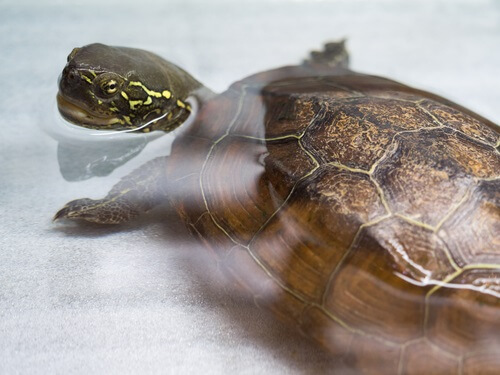
- Origin: Asia
- Price: $35 to $80
- Size: 6 to 9 inches
- Color: Brown, green
One of the smallest turtles on this list, Reeve’s turtle is native to central and eastern China and can be found in North and South Korea, Japan, and Taiwan. These turtles tend to be found in ponds, lakes, and small streams, though they prefer slow-moving and still waters.
Reeve’s turtle is an active species which means, though they may be small, they need a significant amount of space. Each turtle needs at least 5 gallons of water volume, so that means a 10-gallon or 15-gallon tank partially filled with at least 5 gallons of water.
This species can live with other species as long as their habitat requirements are similar, but they aren’t the most social animals. Reeve’s turtles don’t thrive off human contact as much as some other species.
10. Common Musk Turtle (Sternotherus odoratus)
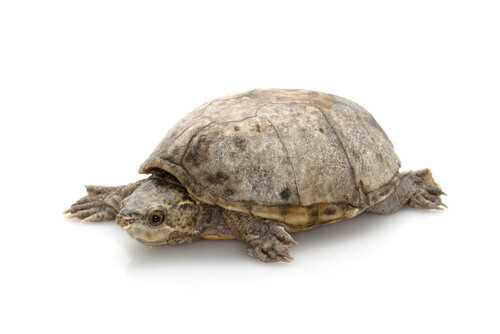
- Origin: North America
- Price: $50 to $100
- Size: Up to 6 inches
- Color: Brown, green
Also known as the stinkpot, musk turtles are one of the most popular aquatic turtle species. These turtles are small in size and have modest care requirements, but they can be a little feisty and don’t tend to like handling as much as other species. When threatened they release a foul, musky odor.
Musk turtles are carnivorous, feeding on a variety of fish, aquatic invertebrates, and carrion. Similar to American mud turtles in many ways, musk turtles are different in that they have a more domed carapace with a distinctive keel running down the middle.
The Benefits of Owning a Pet Turtle
Before you get a new pet, it’s important to understand what you’re getting into. The first thing to remember about reptiles as pets is that they often have long lifespans – this is particularly true for turtles!
These pets have been known to live 20, 30, or even 40 years!
While having a turtle may not be a short-term commitment, it is definitely worth it.
Here are some of the benefits of turtles as pets:
- Turtles are omnivores, so they will eat a wide variety of foods. That being said, you should provide your pet turtle with a balanced diet made up of commercial turtle food supplemented with fresh foods like feeder fish, insects, and leafy greens.
- Pet turtles are fairly inexpensive, especially compared to other reptiles. It’s fairly easy to find pet turtles in the pet store, especially popular species like the Eastern box turtle or painted turtle.
- Most turtles are relatively undemanding in terms of their environment as long as their basic needs are met. Aquatic turtles need an aquatic environment, of course, but terrestrial turtles don’t need much more than a large tank with basic turtle substrate and a basking area.
- You don’t necessarily need a complex habitat for a pet turtle – aquatic turtles do very well in a 20-gallon tank (or larger). Just be sure to match the size of your tank to the size of your turtles.
You may not expect it from a reptile, but turtles can be quirky little creatures. Each species is unique and every individual turtle has its own personality as well.
If you’re looking for a small pet that will always keep you on your toes, turtles make great pets.
What to Know Before Getting a Pet Turtle
While turtles are largely undemanding as pets, that isn’t to say they are the easiest option. Your responsibilities will vary greatly depending whether you choose an aquatic or terrestrial species, and the size of the turtle as well.
Keep in mind that turtles have unique dietary requirements and famously long lifespans – becoming a turtle owner is not for the faint of heart!
Here are some other important things to consider for pet turtles:
- Each species of turtle has its own unique dietary requirements, but most turtle species are omnivores. Turtles eat a wide range of foods including insects, crustaceans, fish, and vegetation.
- Turtles come in a wide variety of sizes with some species growing 20 inches or more. The species you choose determines the size tank you need, so choose wisely. It’s always better to choose a larger tank than you need.
- Some types of turtles are very sociable while others can be quite aggressive. Snapping turtles, for example, are known for having bad tempers while wood turtles are extremely friendly. Think about how much you want to handle or interact with your pet when choosing a type of turtle, especially for young children.
- Different turtle species have different habitat requirements. Aquatic species and semi-aquatic species need access to water in a large tank while land turtles will do fine in a terrarium.
- If you’re considering an aquatic turtle species, think about providing an outdoor enclosure. Depending where you live, you may need to keep your turtles indoors during the winter but an outdoor pond may be an easier and more practical option to give pond turtles a lot of space.
There are hundreds of turtle species out there, but not all of them make great pets. In fact, many turtles are protected, particularly when it comes to selling or purchasing them as juveniles.
If you’re thinking about a turtle as a pet, take what you’ve learned here to decide which type of pet turtle to get then do your own research to make sure you’re fully equipped for proper turtle care.






